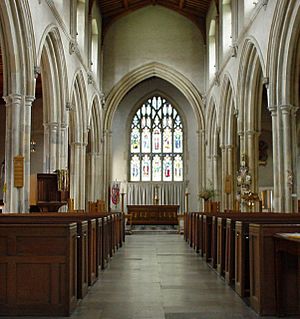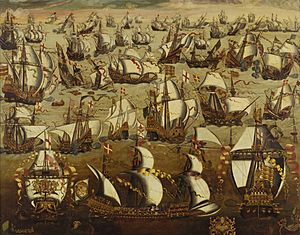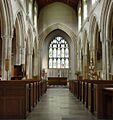Roger Townshend (courtier, died 1590) facts for kids
Quick facts for kids
Roger Townshend
|
|
|---|---|

St Giles Cripplegate, where Sir Roger Townshend was buried
|
|
| Born | c. 1544 |
| Died | 30 June 1590 (aged 45–46) |
| Occupation | Soldier, Knight, Politician |
| Spouse(s) |
|
| Children | Sir John Townshend (died 1603) Sir Robert Townshend |
| Parent(s) | Sir Richard Townshend (died 1551), Katherine Browne |
Sir Roger Townshend (born around 1544 – died June 30, 1590) was an important English nobleman, a politician, a soldier, and a knight. He was the son of Sir Richard Townshend and Katherine Browne. Sir Roger spent much of his career working for Thomas Howard, 4th Duke of Norfolk, and later for the Duke's son, Philip Howard, 20th Earl of Arundel. He was given the title of knight at sea on July 26, 1588, during a famous battle against the Spanish Armada.
Contents
Early Life and Family Connections
Sir Roger Townshend was the oldest son of Sir Richard Townshend, who lived in Brampton, Norfolk. His mother was Katherine Browne. When Sir Roger was very young, his father passed away in 1551.
Sir Roger inherited a lot of land and property from his great-grandfather, also named Sir Roger Townshend. This made him one of the wealthiest gentlemen in East Anglia. He was only about six or seven years old when he received this large inheritance.
Education and Early Career
In 1553, Sir Roger went to Trinity College, Cambridge. However, he did not finish his degree there. By May 1565, he was officially given control of his lands, even though he was still quite young.
Sir Roger's family had a long history of working with the powerful Howard family. Following in their footsteps, Sir Roger began working for Thomas Howard, 4th Duke of Norfolk. His work for the Duke often kept him busy in London. Because of this, he did not take a big part in local government in Norfolk. However, he was chosen to be a Member of Parliament in 1566.
Working with the Howard Family
After the 4th Duke of Norfolk passed away in 1572, Sir Roger continued to work for the Duke's son, Philip Howard, 20th Earl of Arundel. Arundel was still young when his father died. In 1583, Arundel gave Sir Roger and another person, William Dix, control of his movable goods. This was to help pay off Arundel's debts.
Sometimes, Sir Roger and Arundel had disagreements. For example, in 1582, Arundel was annoyed when Sir Roger quickly took him away by boat to Arundel House. This was to stop Arundel from getting involved in a fight between two other noblemen. Later, in 1589, Arundel complained that Sir Roger was being too strict with some of his tenants.
Despite these disagreements, Arundel later showed how much he valued Sir Roger's help. In his last will, Arundel called Sir Roger "my loving friend." He also left him a valuable silver bowl as a gift.
Service to the Queen and Against the Armada
Sir Roger and his second wife, Jane, held positions at the Queen's court. Between 1576 and 1584, they exchanged New Year's gifts with Queen Elizabeth I.

In 1588, Sir Roger served with the English fleet that fought against the Spanish Armada. This was a huge fleet of ships sent by Spain to invade England. On July 26, he was knighted at sea by the Lord Admiral, Charles Howard, 1st Earl of Nottingham. This was a great honor for his service. A picture of Sir Roger was even included in a special tapestry that celebrated England's victory over the Spanish Armada. This tapestry used to hang in the House of Lords.
Sir Roger bought more properties to add to his family's lands in Norfolk. He also bought land in Essex and an estate in Stoke Newington. He passed away in Stoke Newington on June 30, 1590. He was buried at St Giles Cripplegate. His oldest son, Sir John Townshend, took over his estates.
Marriages and Children
Sir Roger Townshend was married two times.
His first wife was Ursula Heydon. They did not have any children together.
His second wife was Jane Stanhope. She was born around 1547 and passed away in 1618. After Sir Roger's death, Jane married Henry Berkeley, 7th Baron Berkeley.
Sir Roger and Jane had two sons:
- Sir John Townshend (died 1603). He married Anne Bacon. Sir John passed away on August 2, 1603, after being seriously injured in a fight.
- Sir Robert Townshend. He was known for being a kind supporter of writers. The famous poet Ben Jonson was one of the writers he helped.
Images for kids





